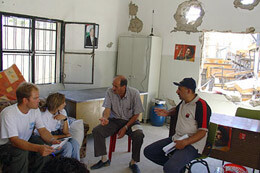United Nations High Commissioner for Refugees 9 September 2006

UNHCR staff discuss needs with municipality staff in the Marjayoun area. (UNHCR/C.Oxenboll)
“What we had here was a tsunami. That is the only way to explain it,” said the mayor of Marjayoun, Fouad Hamra. A convoy of 3,000 fleeing inhabitants came under air attack as they tried to leave on August 11. “The problem is that since there are few destroyed houses, people think that we have not been that much affected by the war.”
Convoys of the UN refugee agency have distributed emergency assistance - mattresses, blankets and other items - in Marjayoun and the surrounding district that uses the same name, but the images seen in most of the world have been of other Lebanese areas where villages were almost entirely destroyed.
“If they were to go inside the houses here they would realise the level of damage that was done,” said Hamra, describing the interiors of 120 houses as a mass of smashed glass and furniture by the time Israeli forces withdrew.
“The needs are tremendous,” said the mayor, who was one of the officials consulted by UNHCR about the needs of the region. “Marjayoun town delivers electricity and water to 10 surrounding villages. It is unable to do so anymore. We now dream about electricity.”
Marjayoun, the largest Lebanese town of the south Beqaa valley, literally means “Plain of the Springs” - a reference to the abundant water sources and springs dotting the fertile land. Only eight kilometres from the border, the market centre has traditionally been a garrison town. It is also known for the mausoleum of the prophet Ezekiel, a shrine three kilometres away, and faces the Crusader castle of Beaufort, built nearly 900 years ago.
The town usually has a population of 3,000, but during the war the population swelled to 30,000 with people who came from other villages and were housed with local families or in public schools. Some 350 displaced Lebanese are still in the town as they cannot return to their own homes. As for the original inhabitants, about half have returned.
“There are a number of agencies and NGOs that have come to us. They need, however, to take the time to understand our needs,” said Ilyas Hamad, another local official in Marjayoun. “Let me give you an example: in this town we do not need food at the moment. We need to clean our farmlands as a matter of priority. We need to do the repairs in the houses before winter to be able to move in.”
UNHCR assessment missions to other municipalities in the area found the full range of problems: the lack of water, sanitation, electricity, the presence of unexploded ordnance and spoiled crops. UNHCR has been able to quickly satisfy some needs - such as requests for blankets, mattresses, tents and kitchen sets - but requirements are far broader and in some cases will take longer to meet.
Fortunately, the Lebanese communities are not passively waiting for outside assistance. While the villagers need help with some problems and want the tools to start rebuilding, they are a resilient group who are helping themselves.
“We may have a huge environmental problem,” the mayor of the nearby town of Klayaa, Bassam El Hasbani told UNHCR. During the conflict, the village was unable to dispose of garbage that piled up - not to mention the dead animals lying around.
“We can solve this in a couple of weeks, if we had the resources to buy the pesticide. That is all that is needed, and the cleaning up we will do,” he said. “Someone has to help us to help ourselves.”
Related Links
